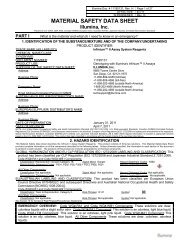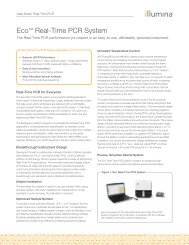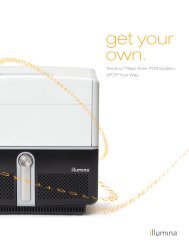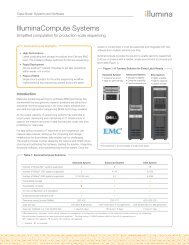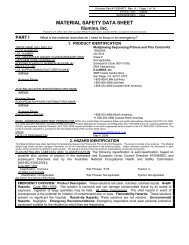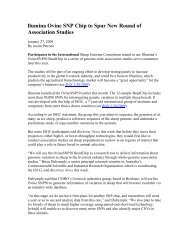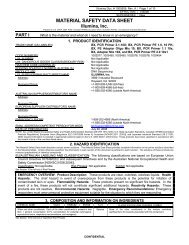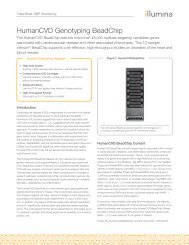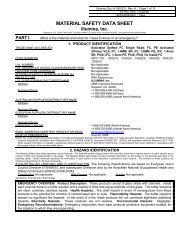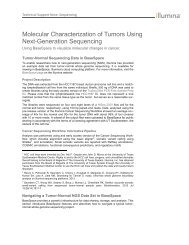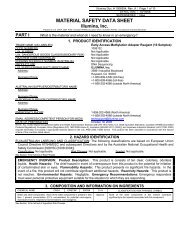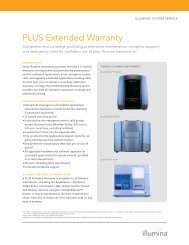MATERIAL SAFETY DATA SHEET - Illumina
MATERIAL SAFETY DATA SHEET - Illumina
MATERIAL SAFETY DATA SHEET - Illumina
Create successful ePaper yourself
Turn your PDF publications into a flip-book with our unique Google optimized e-Paper software.
TruSeq Enrichment Kit <strong>Illumina</strong> Doc. #15018476, Rev. A Page 5 of 17<br />
8. EXPOSURE CONTROLS - PERSONAL PROTECTION (Continued)<br />
EXPOSURE LIMITS/GUIDELINES:<br />
NOTE: Solutions not specifically listed are primarily water and trace constituents; no exposure limits are applicable.<br />
CHEMICAL NAME CAS # EXPOSURE LIMITS IN AIR<br />
ACGIH-TLVs OSHA-PELs NIOSH-RELs NIOSH OTHER<br />
TWA STEL TWA STEL TWA STEL IDLH<br />
mg/m 3 mg/m 3 mg/m 3 mg/m 3 mg/m 3 mg/m 3 mg/m 3 mg/m 3<br />
COMPONENT 1: Code TC#-WS2<br />
Potassium Salt NE NE NE NE NE NE NE NE<br />
Sodium Salt NE NE NE NE NE NE NE NE<br />
Aliphatic Amide 10<br />
(skin)<br />
COMPONENT 3: Code TC#-SMB<br />
NE 10 (skin) NE NE NE NE DFG MAK:<br />
Danger of cutaneous<br />
absorption<br />
Potassium Salt NE NE NE NE NE NE NE NE<br />
Sodium Salt NE NE NE NE NE NE NE NE<br />
Aliphatic Amide 10<br />
(skin)<br />
COMPONENT 4: Code TC#-WS1<br />
NE 10 (skin) NE NE NE NE DFG MAK:<br />
Danger of cutaneous<br />
absorption<br />
Potassium Salt NE NE NE NE NE NE NE NE<br />
Sodium Salt NE NE NE NE NE NE NE NE<br />
Aliphatic Amide 10<br />
(skin)<br />
NE 10 (skin) NE NE NE NE DFG MAK:<br />
Danger of cutaneous<br />
absorption<br />
COMPONENT 5: Code TC#-WS2<br />
Carboxymethyl Hydroxide<br />
NE NE NE NE NE NE NE NE<br />
Compound<br />
COMPONENT 8: Code TC#-ET2<br />
Aliphatic Triol Acetate NE NE NE NE NE NE NE NE<br />
COMPONENT 9: Code GA#-HP3<br />
Alkali Hydroxide NE 2<br />
NE 2<br />
NE 2 NE<br />
NE<br />
(ceiling)<br />
(ceiling)<br />
vacated<br />
1989<br />
PEL<br />
(ceiling)<br />
COMPONENT 10: Code TC#-PMM<br />
Chloride Salt NE NE NE NE NE NE NE NE<br />
NE = Not Established. DSEN = May Cause Dermal Sensitization See Section 16 for Definitions of Other Terms Used<br />
INTERNATIONAL OCCUPATIONAL EXPOSURE LIMITS: In addition to the exposure limit values cited in this<br />
section, other exposure limits have been established by various countries for the components of this product. The<br />
exposure limits given may not be the most current; individual country authorities should be contacted to check on<br />
more current limits.<br />
ALIPHATIC AMIDE:<br />
Australia: TWA = 10 ppm (18 mg/m 3 ), JUL 2008<br />
Belgium: TWA = 10 ppm (18 mg/m 3 ), Skin, MAR<br />
2002<br />
Denmark: TWA = 10 ppm (18 mg/m 3 ), OCT 2002<br />
Finland: TWA = 10 ppm (19 mg/m 3 ), STEL = 20<br />
ppm (37 mg/m 3 ), Skin, SEP 2009<br />
France: VME = 20 ppm (30 mg/m 3 ), FEB 2006<br />
Korea: TWA = 10 ppm (15 mg/m 3 ), skin, 2006<br />
Mexico: TWA = 20 ppm (30 mg/m 3 ); STEL = 30<br />
ppm (45 mg/m 3 ), 2004<br />
The Netherlands: MAC-TGG = 16 mg/m 3 , 2003<br />
New Zealand: TWA = 10 ppm (18 mg/m 3 ), skin,<br />
JAN 2002<br />
Norway: TWA = 10 ppm (18 mg/m 3 ), JAN 1999<br />
Russia: STEL = 3 mg/m 3 , JUN 2003<br />
Sweden: TWA = 10 ppm (20 mg/m 3 ); STEL = 15<br />
ppm (30 mg/m 3 ), Skin, JUN 2005<br />
ALIPHATIC AMIDE (continued):<br />
Switzerland: MAK-W = 10 ppm (18 mg/m 3 ), Skin,<br />
DEC 2006<br />
United Kingdom: TWA = 20 ppm (37 mg/m 3 ); STEL<br />
= 30 ppm, 2005<br />
In Argentina, Bulgaria, Colombia, Jordan,<br />
Singapore, Vietnam check ACGIH TLV<br />
CHLORIDE SALT:<br />
Russia: STEL = 5 mg/m 3 , JUN 2003<br />
ALKALI HYDROXIDE:<br />
Australia: CL = 2 mg/m 3 , JUL 2008<br />
Belgium: TWA = 2 mg/m 3 , MAR 2002<br />
Denmark: CL = 2 mg/m 3 , OCT 2002<br />
Finland: CL = 2 mg/m 3 , SEP 2009<br />
France: VME = 2 mg/m 3 , FEB 2006<br />
Hungary: TWA = 2 mg/m 3 , STEL = 2 mg/m 3 , SEP<br />
2000<br />
Japan: OEL(C) = 2 mg/m 3 , APR 2007<br />
ALKALI HYDROXIDE (continued):<br />
Korea: CL = 2 mg/m 3 , 2006<br />
Mexico: Peak = 2 mg/m 3 , 2004<br />
The Netherlands: MAC-TGG = 2 mg/m 3 , 2003<br />
New Zealand: CL = 2 mg/m 3 , JAN 2002<br />
Norway: TWA = 2 mg/m 3 , JAN 1999<br />
The Philippines: TWA = 2 mg/m 3 , JAN1993<br />
Poland: MAC(TWA) = 0.5 mg/m 3 , MAC(STEL) = 1<br />
mg/m 3 , JAN 1999<br />
Sweden: TWA = 1 mg/m 3 , CL = 2 mg/m 3 (inhalable<br />
dust), JUN 2005<br />
Switzerland: MAK-W = 2 mg/m 3 , KZG-W = 2<br />
mg/m 3 , DEC 2006<br />
Thailand: TWA = 2 mg/m 3 , JAN 1993<br />
Turkey: TWA = 2 mg/m 3 , JAN 1993<br />
United Kingdom: STEL = 2 mg/m 3 , 2005<br />
In Argentina, Bulgaria, Colombia, Jordan,<br />
Singapore, Vietnam check ACGIH TLV<br />
The following information on appropriate Personal Protective Equipment is provided to assist employers in complying with OSHA<br />
regulations found in 29 CFR Subpart I (beginning at 1910.132), equivalent standards of Canada (including CSA Standard Z94.4-02<br />
and CSA Standard Z94.3-07), standards of EU member states (including EN 529:2005 for respiratory PPE, CEN/TR 15419:2006<br />
for hand/body protection, and CR 13464:1999 for face/eye protection), standards of Australia (including AS/NZS 1715:1994 for<br />
respiratory PPE, AS/NZS 4501.2:2006 for protective clothing, AS/NZS 2161.1:2000 for glove selection, and AS/NZS 1336:1997 for<br />
eye protection), or standards of Japan (including JIS T 8116:2005 for glove selection, JIS T 8150:2006 for respiratory PPE, JIS T<br />
8147:2003 for eye protectors, and JIS T 8030:2005 for protective clothing). Please reference applicable regulations and standards<br />
for relevant details.



